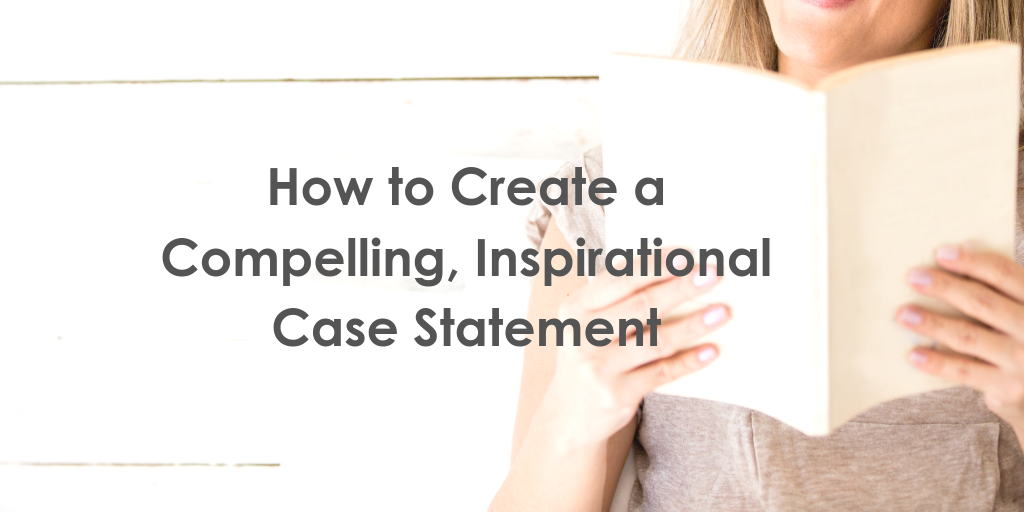How to Create an Inspirational, Compelling Case Statement
Your case statement is the backbone of your fundraising program.
This post is by Dr. Kathryn Gamble, senior consultant with Gail Perry Associates
Why? Your nonprofit’s case statement outlines your entire fundraising rationale: why your organization deserves philanthropic support.
You’re going to have to explain this and lay it out – so people can understand it quickly.
Don’t forget: people make gifts to nonprofit organizations for many reasons.
But the most important reason of all is this: they want to make a difference regarding some issue they care about deeply.
People make giving decisions based on their feelings first.
Then they back up the decision with logic. Above all, the giving decision is emotional first, and logical second.
Therefore, your nonprofit’s case statement needs to evoke real feelings for the work you do – whether is it sad, angry, happy, peaceful or something else.
Here are key elements that your case statement should include to create a donor-centered case statement.
1. First, describe the societal need or problem your organization addresses.
Do you serve the homeless? Then tell a story of the plight of the homeless.
Add just a few numbers (statistics) to help describe the scope of the problem.
You can do this for any organization – the community arts center, the community college, environmental organizations.
Every nonprofit organization exists to address a need and/or problem.
A brief description of that need/problem helps to frame the work your organization does.
2. Describe HOW your organization addresses the societal need or problem.
This is NOT a list of your programs. This should be a story about what your programs do.
Let’s go back to the homeless example. Your organization provides services to the homeless.
If you are a shelter, then your story may be about how you help the homeless stay warm, dry and fed.
If you are the community arts center, your story is about being a place people can express their creativity while learning a new skill or kids can attend art camp.
You want the reader to FEEL the impact your make through your programs.
3. Explain WHY what you do is important.
This is about your organization’s values.
Maybe your organization values human creativity and exploration.
Or, your organization may believe that to love our neighbor means we lend a helping hand.
The most essential part of your case is WHY your organization’s work is important.
This is where the reader may FEEL a connection – a resonance with their own values. If you can achieve this connection now you will have the reader’s interest.
And now. . . it’s time to back up the feelings with just a little logic.
4. Include a statement about who and where you serve – your “market.”
You may serve the homeless in a particular county or region.
Your arts center may serve several counties or just one city.
Some organizations are international or national in scope.
You just want the reader to know where you do your work and who you are serving – it grounds your work in reality.
5. Share your organization’s qualifications to carry out its work.
You want to describe your particular expertise – especially your staff’s credentials.
Does your organization’s work require you have medical personnel or teachers? You may want to include short bios on key staff.
Is your organization required to have some kind of accreditation or licensure to operate?
Has your organization been recognized for its expertise or maybe a key staff person has been recognized?
The point is to demonstrate your organization’s credibility in its field – this helps to build your donors’ trust.
It’s also great to include a list of your board members. This demonstrates community support for your organization, which is so very important.
Here you want to connect the feelings with the logic.
6. Describe the financial objectives that private philanthropy will support.
It is tempting just to say we want to raise X and leave it at that.
Or sometimes people include a budget. Not going to work!
Instead, use the MPI approach here – Money, Project, Impact.
It goes like this: We seek to raise $$ (Money) to expand our Program (this is the project) so we will have this (Impact.)
Now the reader will understand what investment it will take so your organization can address the need/problem and impact the need/problem for society in the market you serve.
BOTTOM LINE: What your nonprofit’s case statement can do and what it can’t.
You may recall the old marketing model AIDA – Awareness, Interest, Desire, Action.
The case statement mainly will create Awareness and inspire Interest. You might even get to Desire in some cases.
You are laying the groundwork for an ask. To move the prospective donor to ACTION – this takes more work.
Your case statement is a great tool to generate Awareness, Interest and Desire – but it will never replace good old-fashioned person-to-person relationship building!




